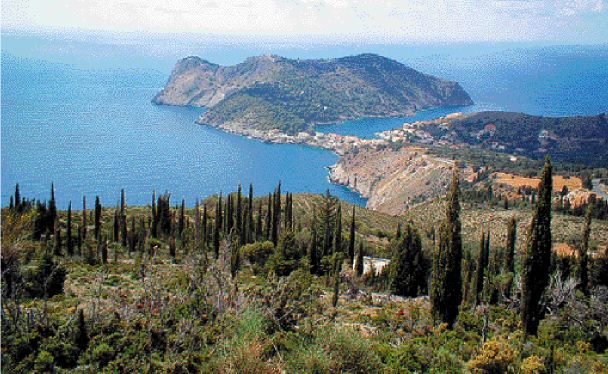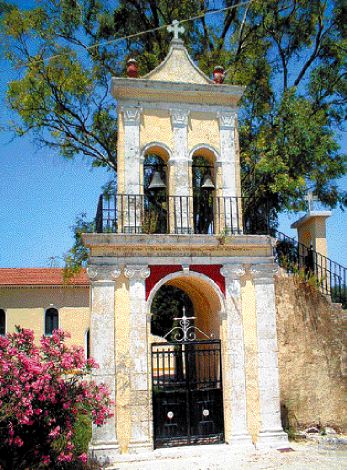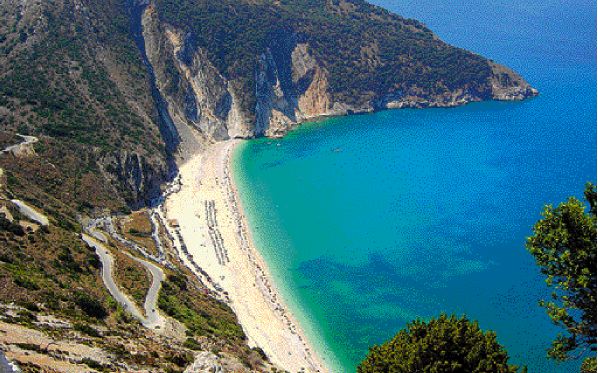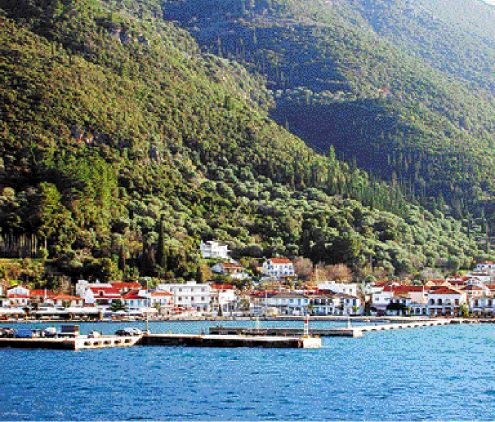 |
||
|
Kefalonia, the Wild Isle
|
||
|
THE BEST way to approach Kefalonia is by boat. Sailing from the port of Patras or Kyllini on the west coast of the Peleponnese, Kefalonia first appears as a dark blue land mass on the horizon, almost indistinguishable from the shimmering sea mist. But as the boat surges on through the Ionian Sea, the hills and mountains gain definition until you see the rugged mountain peak of Ainos towering high above the sea. Finally, there can be no confusion with Zakynthos, the neighbouring island to the south, an altogether different place, a gentler, low lying island. As the boat nears the port of |
 The little village of Assos on the western coast of the island |
|
| Poros on the east side of the island, sheer-sided hills cloaked in dense woodland and maquis slope towards the turquoise seas. Apart from the little town clustered around the port, there is hardly a sign of civilisation. And this is not a misleading representation, for Kefalonia is essentially a wild isle. The island is the largest and most topographically complex of the Ionian group of seven, but its relatively small population of 45,000 is concentrated on the fertile plains and valleys, leaving the mountainous interior virtually deserted. Mad islanders The reputation of the Kefalonians precede them: lunacy is the one Greeks love to tell you about - indeed the Kefalonians themselves tell their visitors, albeit with a humorous twinkle in their eye, that they are known as the madmen of Greece. One shopkeeper told me that American psychiatric researchers frequently visit the island where they are forever discovering new phobias never known before to humankind. It's often said that the line between genius and lunacy is thin, and Kefalonians are equally known for their intelligence - many an islander will tell you that more doctors in Greece originate from Kefalonia than any other island. And Kefalonians have always had a reputation for their enterprising nature - many have sought their fortunes abroad, especially during periods of economic distress in their homeland. One thing I can certainly vouch for from my experience of living there for three years is their sense of humour: they have an endless ability to self-satirise. |
||
Like many islanders, they are independent too, and proud. Tour operators tried to move in to do business in the 1970s but they found obstacles not only in the mountainous terrain of the island - difficult to manoeuvre their tour buses around - but they also discovered that the people themselves did not welcome them with open arms. They were resistant to the idea of mass tourism, unlike neighbouring Corfu and Zakynthos, preferring to do it their way. Nonetheless, Kefalonia' airport opened in the early 1980s, and package tourism is now of major significance to the island's economy. Louis de Berniere's novel, Captain Corelli's Mandolin, undoubtedly raised the profile of the island and the release of the film in 2002 opened up the beauty of the place to a huge audience. This happened at more or less the same time as the advent of the euro and the two events combined seem to have accelerated |
 A Venetian bell tower, one of the remains from when the island was part of the Venetian Empire |
|
| the development of real estate over the last five years, with estate agents proliferating, especially around the capital, Argostoli. Driving around the countryside south of this little town, it sometimes feels like the whole area is up for sale. To their credit, the islanders haven't really sold out to Corelli though - there are very few namesake tavernas and bars, and Corelli tourist trails didn't really last. The furore that surrounded the film was, for the Kefalonians, just another marker point in their colourful history. And colourful it is. The love story told in Corelli is set on Kefalonia during the Second World War, where tragic slaughter took place. In September 1943, about a month after the fall of Mussolini and Italy's capitulation, the Italian soldiers who had been occupying the island were massacred by the Nazis, their former allies. As the Germans invaded, the Italians fought them heroically to the end, but eventually the entire garrison was systematically rounded up and shot. Some say the bodies were burned while others say they were taken out to sea on barges and sunk. Whichever, the number of casualties remains unclear, but there were at least four thousand and, perhaps, ten. There is a memorial to the Italian soldiers who died on the hill that rises up behind Argostoli, signposted from the loop road, the Piccolo Yiro, that links the main tourist resort of Lassi with Argostoli. |
||
Tragedy strikes Ten years later came the event that was to shape the island's social and economic character over the next decades more than any other: on the night of 12 August 1953, a cataclysmic earthquake flattened most of the fabric of the island. Sitting close to the fault line that makes this one of Greece's most active seismic areas, Zakynthos, Lefkas and Ithaca suffered too. Faced with such devastation many of the population migrated to Athens, the USA, Australia and South Africa. There had previously existed |
 Myrtos, with its breathtaking sandy beaches |
|
| 365 villages on the island and the number is still greatly reduced; however, nowadays the population is increasing due to the growing number of northern Europeans settling there - mostly Britains but also Dutch, Swedes and Germans. To some extent, the sons and daughters of emigres are returning to their motherland now that the island's economy is in better shape. |
||
The '53 earthquake explains the almost total lack of historical architecture in Kefalonia. The small fishing harbour of Fiskardo on the northern tip of the island is the only settlement that escaped virtually unscathed. Together with parts of the little village of Assos on the western coast, whose pretty harbour lies in the shadow of a Venetian fort, one gets a glimpse of the finely proportioned Venetian architecture and cultural heritage that was once predominant on the island. A Venetian legacy The Ionian islands undoubtedly have a distinctive flavour from the rest of Greece - the difference is partly due to higher rainfall and greener landscapes - but the distinction runs much deeper than this. This group of |
 The port of Poros with a backdrop of dense woodland |
|
|
islands on Greece's western side have looked to the West more than the East over the last 500 years and this is in no small part due to the fact that they were part of the Venetian Empire for four hundred years, rather than under Ottoman rule. There were various skirmishes with the Turks - the first wave of Turkish attacks were led by bloodthirsty Ahmed Pasha. The story goes that he chopped up all the nobility, burnt the castle of Kefalonia and transported many of the peasants to Constantinople. There, the sultan separated the men from the women and forced the men to marry women from Ethiopia and vice versa, in order to create a race of people to use as slaves.
However, these skirmishes only resulted in a brief period of Turkish rule from 1485-1500 when the Venetians regained control. Kefalonia was a strategic stepping stone to the east and it provided important shelter for the Venetian fleet. Venetian culture influenced architecture, fashion, arts, music, letters, education, health systems and laws. It was also the Venetians who were responsible for planting many of the olive trees still to be found on the island by rewarding islanders with money for each tree planted. St George's castle was the island's political centre for most of this period. In 1757 another huge earthquake damaged the fort considerably and this seems to have been the catalyst for moving the capital down to the sheltered bay within a bay, Argostoli, where advantage could be taken of the trading opportunities provided by such a position. The threat from piracy had diminished and it was deemed safe enough to locate the capital by the sea. If you wonder why some of the old villages are situated in seemingly inhospitable places up on the hillsides, the reason was defence - settlements needed to be well away from the coast and the Saracen (north African pirates) threat. Rumour has it that a series of tunnels once linked St George's fort with Argostoli five km to the south; it is said that the few Italian soldiers who survived the 1943 massacre were led to safety through those tunnels by islanders. St George's and the Venetian fort at Assos have both been renovated with EU funding recently and are well worth a visit for the views alone. Venetian rule came to an end in 1797 when the French gained control of Venice's overseas possessions. After the Napoleonic wars the British took control in the early years of the 19th century - the only popular governor of the seventeen to come Kefalonia's way was Sir Charles Napier - he had great affection for the island, even naming one of his daughters Emily Kefalonia Napier. His loyalty to Greece is evidenced by the fact that he supported the mainland during the War of Independence against the Ottoman Empire, despite Britain's official opposition. The Napier gardens created in his memory in central Argostoli have recently had a facelift of sorts. The Piccolo Yiro, or short circuit, was the name used by Napier for the carriage promenade from Argostoli to the Lassi area. Locals also say that Lassi was so named because he declared that the area was as "bonny as a Lassy girl". Along the Piccolo Yiro lie the Swallow holes of Katovothres, a unique geological phenomenon where water is sucked underground. What happened to that water remained a mystery until 1963 when dyes were dropped into the water to see where it went. The dyed water was found to re-emerge fourteen days later at Karavomylos, having passed through the spectacular underground lake at Melissani, about three kms outside of the port of Sami on the east coast. This means that the water had run through subterranean tunnels across the full width of Kefalonia. An English resident, Mr Stevens, spotted the potential for water power at the point where the sea water disappeared and built some huge sea mills at Katovothres in 1835 to grind corn. The mill was dismantled in 2000, because it had become unsafe but it has now been resurrected. A very smart taverna with a delightful shaded terrace has opened there. If you feel like splashing out, locals tell me it's well worth it for something a little upmarket (see where to eat). * How to get there |
||
|
|
||
(Posting Date 8 August 2006) HCS readers can view other excellent articles by this writer in the News & Issues and other sections of our extensive, permanent archives at the URL http://www.helleniccomserve.com./contents.html
All articles of Athens News appearing on HCS have been reprinted with permission. |
||
|
||
|
2000 © Hellenic Communication Service, L.L.C. All Rights Reserved. http://www.HellenicComServe.com |
||

